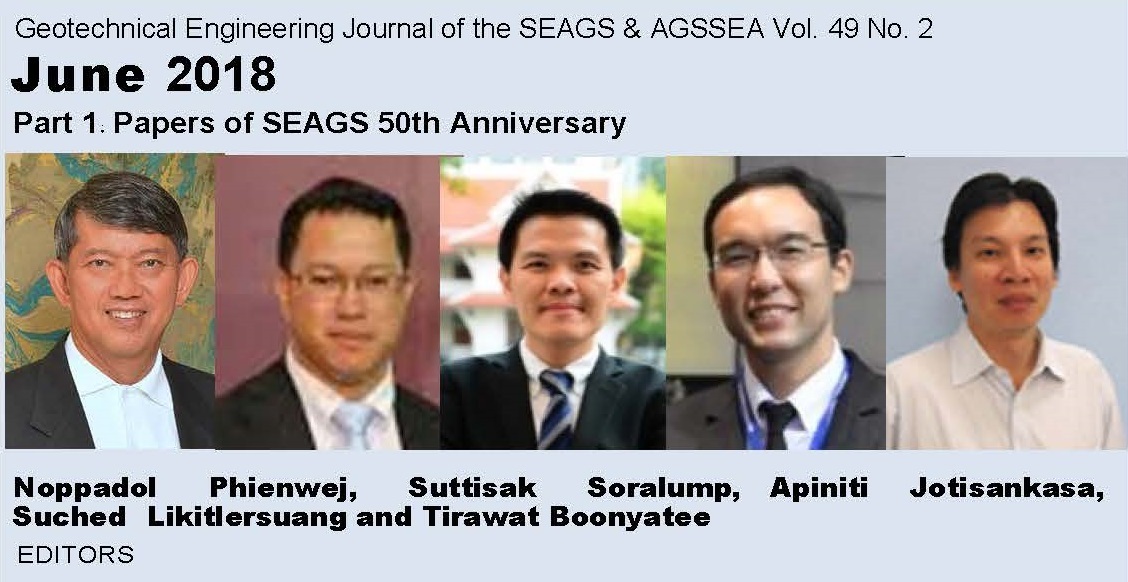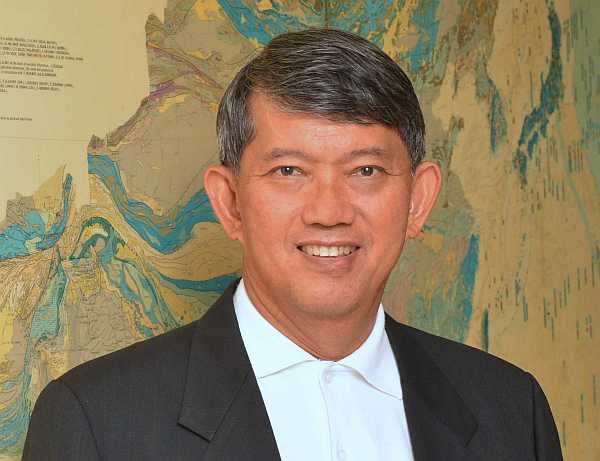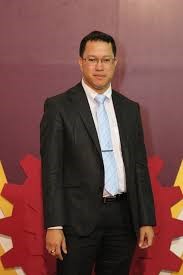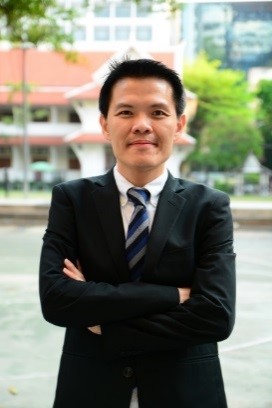
Dr. Noppadol Phienwej

Dr. Noppadol was an Associate Professor in Geotechnical and Earth Resources Engineering in AIT’s School of Engineering and Technology (SET).He became SEAGS President in May 2016. Prior to taking over as President, Dr. Noppadol was serving as Honorary Secretary General of SEAGS. Other AIT faculty members who have served as Secretary General of the Society include Dr. John Nelson (1970-1973), Prof. A.S. Balasubramaniam 1972-2000), and Prof. D.T. Bergado (2000-2013). Prof. Balasubramaniam has also served as President from 1985 – 1987. AIT’s association with SEAGS stems back from 1967, when the Society was founded at AIT Bangkok by Dr Za-Chieh Moh, a former AIT faculty member, to cover Thailand, Malaysia, Singapore, Hong Kong and Taiwan and other societies in Asia. With a membership of over 200, the Society members are active in soil mechanics and foundation engineering, engineering geology, rock mechanics and geosynthetic engineering.
Dr. Suttisak Soralump

Dr. Suttisak Soralump is currently an Associate Professor at Kasetsart University in Bangkok, Thailand. He is also the President of the Thai Geotechnical Society. An Alumnus of Chulalongkorn University in 1994, he is also a Distinguished AIT Alumnus who received his Doctoral Degree from Utah State University in 2001. Dr Suttisak has wide range of Geotechnical Engineering interest and these include: ground improvement techniques, risk assessment and analysis of dams, dam engineering, probabilistic analyses, as well as field and laboratory testings. Dr Suttisak is an active geotechnical consultant in Thailand and under his leadership; the Thai Geotechnical Society has arranged conferences, symposia and courses. The Annual Thai Geotechnical Conferences are worthy of praise.
Prof. Suched Likitlersuang

Prof Suched Likitlersuang is currently a full professor at the Department of Civil Engineering, Faculty of Engineering, Chulalongkorn University. He joined the Department of Civil Engineering at Chulalongkorn University as a lecturer (2004-2006), as an assistant professor (2006-2009) and as an associate professor (2009-2011). He was promoted to full professorship in 2011. He is also the founder of the Geotechnical Research Unit, which came into being in early 2016. His research interests include constitutive modeling for geomaterial, stress-strain characteristic of soils, numerical analysis in geomechanics, pavement engineering, geoenvironments, geotechnical earthquake engineering and soil bioengineering. He has supervised 24 Master and 10 Ph.D. students. He has published over 80 articles in international conference proceedings and international journals. Suched Likitlersuang was born in Bangkok. He graduated with a bachelor degree in civil engineering from Chulalongkorn University in 1998 and received a master degree in geotechnical engineering from Asian Institute of Technology in 2000. He obtained a doctorate in civil engineering from the University of Oxford in 2004.
His contributions through research to innovative design and construction practices in geotechnical engineering and problematic ground improvement have been widely recognized. He received many research grants from national and international agencies. Recently, his works have moved closer to industrial needs by collaborating with the private and non-governmental sector in the implementation of innovative research-based solution. He is a member of the Thai Geotechnical Society and the Engineering Institute of Thailand. He is also an Editorial Board member of Geotechnical Research and serves as Editor of the Southeast Asian Geotechnical Society Journal. He has also served as a reviewer in many reputable journals.
Dr. Apiniti Jotisankasa
Dr. Apiniti  is currently an Associate Professor at Department of Civil Engineering, Kasestsart University Bangkok. After obtaining his BEng degree in Civil Engineering from Kasetsart University in 1999, he pursued his MSc and PhD in Soil Mechanics at Imperial College London with the generous support of the Anandamahidol Scholarship from Thailand. His research topics were the Collapse behaviour of compacted silty clay.
is currently an Associate Professor at Department of Civil Engineering, Kasestsart University Bangkok. After obtaining his BEng degree in Civil Engineering from Kasetsart University in 1999, he pursued his MSc and PhD in Soil Mechanics at Imperial College London with the generous support of the Anandamahidol Scholarship from Thailand. His research topics were the Collapse behaviour of compacted silty clay.
Since 2005, he focused his research activities on application of unsaturated soil mechanics on practical geotechnical engineering problems, such as rainfall-induced landslide, excavation, embankment stability, bio-slope engineering, geohazard mitigation, as well as other issues such as energy piles, tree stability, and geophysics investigation for tree root architecture. He and his team has been developing a system for monitoring slope behaviour such as suction, pore water pressure, slope movement and earth pressure. Dr. Apiniti is the recipient of the best paper award (Geotechnical Engineering) in the National Convention in Civil Engineering twice in 2009 and 2012 from the Thai Geotechnical Society and Chai Mukthabhan foundation for his comprehensive works on the behaviour of slopes subject to rainfall.
In 2011, he was awarded the Young Technologist Award from the Foundation for the Promotion of Science and Technology under the Patronage of His Majesty the King of Thailand. Dr. Apiniti has been international Secretary General of the Thai Geotechnical Society since 2009 and currently a member of the TC106 (Unsaturated soils) of the International Society of Soil Mechanics and Geotechnical Engineering. Currently; he is a committee member of the Chaipattana Foundation working on the project on landslide hazard mitigation by the use of vegetation and engineering methods.
Dr. Apiniti was a conference secretary of the 5th Asia-Pacific conference on unsaturated soil in 2012 and the 50th anniversary symposium of SEAGS in 2017. Currently, he serves as an editorial board member of Soils and Foundations Journal of the Japanese Geotechnical Society and International Journal of Geosynthetics and Ground Engineering, Springer.
Dr. Tirawat Boonyatee

Dr. Tirawat Boonyatee is currently an Associate Professor in Geotechnical Engineering at the Department of Civil Engineering, Faculty of Engineering, Chulalongkorn University. He obtained his B.Eng. (Civil Engineering) at Chulalongkorn University, Thailand, in 1995 and furthers his studies at Kyoto University, Japan where he obtained his M.Eng. (Civil Engineering) in 1998 and D.Eng. (Civil Engineering) in 2001 respectively. Dr Tirawat Boonyatee is a committee member of Subcommittee on Geotechnical in Civil Engineering Committee of The Engineering Institute of Thailand Under H.M. The King’s Patronage.
PREFACE
This volume contains 20 papers from invited authors from SEAGS-AGSSEA member countries, Japan, Korea, India and elsewhere.
1. The first paper by Charles W.W. Ng, Jason L. Coo & Anthony Gunawan deals with “State-of-the-Art Research in Geo-energy and Geo-environmental Engineering: Energy Pile and Earthen Capillary Landfill Cover System”. Geo-energy and geo-environment are two branches of geotechnical engineering representing current and future grant challenges because of the pressing need to conserve energy and protect the environment. The Hong Kong University of Science and Technology has been actively seeking solutions to these two challenges. The first part (geo-energy) of this paper describes a series of novel cyclic heating and cooling centrifuge tests performed on replacement and displacement floating energy piles installed in both saturated sand and clay. The test results reveal that replacement floating energy piles exhibit ratcheting settlement under a constant working load but at a reducing rate when subjected to temperature cycles, irrespective of the type of soil in which they are embedded. On the contrary, displacement floating energy piles exhibit heave behaviour. No existing theoretical model can capture observed ratcheting pile settlement well. This suggests that care must be taken when designing replacement floating energy piles. In the second part (geo-environment) of the paper, a novel three-layer environmentally friendly earthen cover system for climate regions like Thailand, Indonesia, the Philippines, Malaysia and Singapore is investigated through theoretical examination, physical modelling (e.g., one-dimensional soil column and two dimensional large flume tests), and advanced numerical simulations. This novel cover system consists of a fine-grained soil underneath a conventional two-layer cover with capillary barrier effects. Two-dimensional water infiltration experiments and numerical simulations show that the newly introduced fine-grained soil layer can greatly minimize rainfall infiltration even after a 4-h rainfall event having a return period of 100 years in climate regions. One-dimensional gas emission tests and numerical simulations reveal that a minimum of 0.6 m thick fine grained soil layer compacted at 10% saturation (e.g. those in arid regions) can adequately satisfy the Australian guidelines. No geomembrane is needed. This new environmentally friendly and robust earthen landfill cover system is thus a promising alternative to other landfill covers for minimizing rainfall infiltration and landfill gas emission under all kinds of weather conditions.
2. Yin & Feng in the second paper deal with the “validation of a new simplified Hypothesis B method for calculating consolidation settlement of clayey soils exhibiting creep”. This paper introduces a new simplified Hypothesis B method for calculating consolidation settlement of clayey soils exhibiting creep. The general equations of the new simplified Hypothesis B method are presented and explained first. After this, four different cases are used to examine the validation of this new method. The first case is a single layer of clay with test data. Two fully coupled finite element (FE) programs, the new method, and Hypothesis A method are used to calculate the consolidation settlements of the clay which are compared with test data. The second case is one layer of Hong Kong Marine Deposits (HKMD) with four different over-consolidation ratios. Again, the two FE programs, the new method, and Hypothesis A method are used to calculate the consolidation settlements of the HKMD with results compared and relative errors obtained. The third case is two layers of soils: one is HKMD and the other is Alluvium. One commercial FE program, the new method, and Hypothesis A method are used to calculate the consolidation settlements of this two-layer system. Two methods for determining the average degree of consolidation of the two layers are used in the new simplified method. All results in this case are compared with relative errors obtained. The fourth case is one layer of Hong Kong Marine Deposits (HKMD) with vertical drain. The commercial FE program, the new method, and Hypothesis A method are used to calculate the consolidation settlements of this HKMD with vertical drain. Two methods for determining the average degree of consolidation of the HKMD with vertical drain are used in the new simplified method. Results from the FE analysis and the new method are compared with relative errors obtained. From the above validation cases, it is found that the settlements from the new simplified Hypothesis B method are closer to test data or the values from the fully coupled finite element modelling with least relative errors. Hypothesis A normally underestimates the settlement a lot and with largest errors when compared with Hypothesis B. The main conclusion is that the new simplified Hypothesis B method is very suitable for calculating consolidation settlement of clayey soils exhibiting creep and is easy to use by simple spreadsheet calculation.
3. The third paper is by Chao-Kuang Hsueh et al on “Finite Element Analysis to Characterize the Lateral Behaviour of a Capped Pile Group”. Finite element simulation for analysis of a capped pile group was conducted to investigate the interaction among piles, soil and pile cap, especially the effects resulted from concrete damaging. The simulation was to develop a calibrated model using the test data and to apply that model for conditions not present during the test. In addition to consider pile/soil and cap/pile interaction in the numerical simulation, interaction between steel reinforcement and concrete was also modelled in the analysis. In the numerical analysis each steel reinforcement installed in the tested piles and the pile cap was modelled as an individual element at its installed position. The simulation results showed that the leading and the middle row piles in the group carried the highest and the lowest fraction of pile head loads when concrete around the pile cap/soil contact area remained its integrity. Increasing loading level, the pile head load carried by the middle row of piles increased due to constraint of the pile cap affected by the concrete damage at the pile cap/soil contact zone.
4. The fourth paper is by Tjie Leong Gouw on “Proposed Design Guideline of Dynamic Compaction for Practicing Engineers”. During an earthquake, saturated fine sands tend to lose its bearing capacity due to the earthquake induced and accumulated excess pore water pressure. The phenomenon, known as liquefaction, is one of the earthquake hazards that need to be mitigated in an earthquake prone area such as the archipelagos of Indonesia. The occurrence of an earthquake cannot be prevented and, with the present knowledge, is difficult – if not impossible – to predict. However, liquefaction potential can be mitigated by carrying out proper ground improvement methods. The most common ground improvement schemes that have been widely implemented in mitigating liquefaction potential of saturated fine sands in Indonesia are dynamic compaction and vibro-compaction. However, many practicing engineers are still not familiar with the methods. This paper presents the design, execution, and evaluation methods of dynamic compaction. Two case histories on real projects are also presented as examples.
5. Yasuhara et al are authors of the fifth paper on “Settlement of river dykes and their adjacent residences on soft clay deposits after the Tohoku-Pacific Ocean Earthquake of 2011.” Among the cases of extensive infrastructural collapse that resulted from the cataclysmic earthquake that struck off the eastern coast of Japan on March 11, 2011, long-term settlement and deformation of clay deposits during earthquakes have sometimes been overlooked. This paper presents a case history of clay deposit settlement and deformation beneath river dykes and their adjacent residences after the Great East Japan Earthquake in 2011. As a countermeasure against damage of this kind, parts of existing river dykes were removed and then sheet piles were installed immediately after the earthquake at the toes of river dykes. Thereafter, the river dykes were returned to the original height by surcharging the fills for dykes. In addition to measurement of river dyke and residence behavior after those countermeasures, numerical analysis was conducted using ALID software for dynamic analysis of behavior during earthquakes and DACSAR software for static analysis of post-earthquake behavior to predict settlement and deformation of deposits consisting of the thick clay layer underlying the sand layer and to verify effectiveness of the countermeasures.
6. Sixth paper is by Dong Huyn Kim et al on Application of photogrammetry and image processing for rock slope investigation: High-resolution 3D photogrammetric models facilitate the generation of rock surface attributes which can be used to highlight the products of weathering on rock slopes. Recent studies of image analysis have also demonstrated that if the features of interest are clearly visible in digital photographs, various surface features which are associated with its weathering characteristics can be investigated using image analysis techniques. However, combining their potential of both 3D and 2D images for providing more reliable data, these approaches are computationally complicated and difficult to implement. This article presents an image analysis workflow via a MATLAB image filtering code for the estimation of a recession area focusing on the variation of rock surface roughness. By comparing annual photogrammetric 3D images, the roughness variations were processed with relative brightness integers (I) obtained from their greyscale images. The results show that the loss of roughness on the exposed surface appeared to be strongly related to the changes of brightness integers (I) derived from filtered greyscale images. The combined image analysis with 3D photogrammetric models could compensate the limitations of the uses of both digital photographs and 3D surface models for quantifying weathering patterns.
7. The seventh paper is by Boon & Ooi on advances in tunnelling Geotechnics – stacked twin tunnels: The construction of underground metro projects involves both tunnelling and deep excavations for station construction. The construction programme of the contractor needs to take into account the time required for excavating the launching shaft or station to launch the tunnel boring machines (TBMs), and also the interfacing of the tunnelling activities with the intermediate stations located in between the launching and retrieval shafts or stations. Risks in construction programme may arise in a project for instance due to land issues such as merger and acquisition or relocation of the original land occupants. The risks in construction programme can nonetheless be addressed through design provided there is strong understanding of its mechanics. This also allows more optimal construction programmes to be developed at the outset of a project. An example is demonstrated for the unusual case of stacked twin tunnels in residual soils where the upper tunnel is constructed first and undermined subsequently by the lower tunnel. The mathematics and the mechanics governing their interactions are detailed.
8. Shaw-Shong Liew is the author of the eighth paper on Common Blind Spots in Ground Investigation, Design, Construction, Performance Monitoring and Feedbacks in Geotechnical Engineering: In geotechnical engineering dealing with risks and uncertainties, the processes involved start from the investigation with the fundamental intention to attain better understanding of the subsurface conditions and acquisition of the engineering parameters for the subsequent engineering analyses, designs, detailing, tender documentation and calling, followed by design validation tests at field and construction problem solving. With the forensic investigation experiences by the author in the past, some interesting findings and surprises are compiled in this paper to illustrate these common blind spots at the aforementioned engineering processes. The importance of desk study and sound geological knowledge in planning of investigation programme have not received sufficient emphasis in the higher education system, thus resulting in significant wastage by the trained graduate in using the investigating tools and generating excessive amount of redundant information. Some of the mistakes are fundamental errors in perceiving the engineering behaviours when using the software with intuitive and illusive perception rather than based on sound engineering understanding. There is also strain compatibility issue in mobilising material strength of composite materials with drastic stiffness contrast when approaching failure state of a soil structure interaction problems. Design validation tests are crucial to ensure design methods adopted able to reasonably behave as intended. However, the tests usually do not reveal the overall behaviours of the design in actual scale and time factors, but rather a behaviours of a special case or prototype. Geotechnical instrumentation on a larger scale with time might be a more representative of practical performance with totality. This will be more useful for review and back-analysed of a big picture performance of the geotechnical structures.
9. The ninth paper is by Dr Dominic Ong on “detrimental effects of lateral soil movements on pile behaviour”. Deep excavation, tunnelling and river tidal fluctuations are some activities that can induce lateral soil movements, which can detrimentally impact nearby existing infrastructure. One major design concern is that the behaviour and mechanisms of complex soil-structure interaction that occur in these situations are often still not well understood. Limited design methods are currently available to evaluate these problems in practice. Therefore, the latest development and understanding of soil-structure interaction involving pile foundations subject to lateral soil movements are presented with reference to successfully implemented projects and research outcomes based on finite element modelling, centrifuge experiments as well as field observations and interpretations. The novel concept of passive pile behaviour and limiting soil pressure due to stress relief will be evaluated and explained in detail.
10. Tenth paper is by Siau Chen Chian on Optimising Cement Dosage in Ground Improvement and Early Quality Control Schemes: Judicious dosage of cement in soft clayey soils is key in reducing waste, time and cost in this growingly environmental conscious modern society. Despite being a well-established technique in ground improvement, studies on the prediction of strength development of cement stabilised soils are often limited to a couple of clay types or site specific. This paper presents an extensive suite of unconfined compressive strength tests of cement-mixed clayey soils over a wide range of mix ratios, curing ages and sand impurities. A strength predictive model encompassing the above variables was developed and validated with several types of clay and cement from different sources. This enables the optimisation of cement dosage to achieve a desirable unconfined compressive strength to satisfy the ground improvement criteria with ease. Quality control schemes using early age strength and portable bender element were also discussed in this paper.
11. Effects of Preloading of Struts on Retaining Structures in Deep Excavations” is the eleventh paper by Richard N. Hwang and Lup-Wong Wong. The performance of an excavation of 19.4 m in depth in soft ground has been reviewed by interpreting the readings of inclinometers in wall of 35 m in length and strain gauges in six levels of struts. Assuming the wall deflections at the first strut level would not move after preloading, the corrected inclinometer readings show that the deflections at the wall toes and at the tips of inclinometers were as much as 43 % and 25 % of the maximum wall deflections respectively. The large toe and tip movements are verified by numerical analyses, which have been conducted to study the effects of preloading of struts as well. The strain gauge readings show that the preloads applied to the struts do not sustain and drop significantly after subsequent preloading of struts. Four cases, namely, struts with full preloads, 50% preload to the first strut level, zero preload and actually observed preloads, have been adopted in the analyses to evaluate the effects of preloads. The results of the numerical analyses using the Mohr-Coulomb model are then compared with the observed wall deflection profiles in the final excavation stages. The Young’s moduli for clay and sand layers have been correlated with the soil strengths. It is found that computed peak strut loads are in agreement with the observed peak loads for the upper 3 levels of struts. For the lower 3 levels, the computed strut loads are however as much as 50% larger than those observed.
12. The twelfth paper in this volume is by Hung Jiun Liao et al on Anchors of Anchored Slopes in Taiwan: A catastrophic failure of an anchored cut slope at the national expressway in 2010 uncovered the status quo of tie-back anchors in Taiwan. Serious corrosion of anchor components due to poor corrosion protection was found to be the most obvious factor contributing to this landslide among other factors. After an extensive island-wide investigation on the existing anchored slopes, similar corrosion problem was found in many other anchored slopes. After the investigation, the construction and maintenance practice of anchored slopes had been fundamentally changed in Taiwan. This paper covers the inspection results on anchored slopes and also the measures taken to improve the corrosion protection of existing anchors and new anchors. Based on the problems found from the existing anchored slopes, some modifications on anchor tendon assembly and cement grouting practice had been developed to upgrade the corrosion protection of the new anchors and to monitor the long-term anchor load change as well.
13. The thirteenth paper is by Chiwan Hsieh et al. on Hexagonal Wire Mesh Panel Tensile Behaviour due to Weaving Patterns. The tensile engineering properties of a commonly used wire mesh (120mm x150mm, ψ=4.0mm) with triple-twist (Type A) and fourth-twist (Type B) weaving methods according to the ASTM A975 test standard are studied. Wire mesh panel tensile tests loaded in the longitudinal and transverse directions with and without centre cut wire conditions and panel connection to selvedge tests were evaluated. Generally, the longitudinal tensile strengths were higher than that for the transverse tensile strengths. The Type B panel longitudinal and transverse direction tensile strengths and connection to selvedge strengths were all greater than those for Type A panel. In addition, the Type B panel showed better strength retention rates than the Type A panel with and without centre cut wire condition. The Type B panel showed better tensile behaviour than the Type A panel.
14. Keh-Jian Shou et al. are the authors of the fourteenth paper on Trenchless Excavations for Underground Pipelines in Difficult Geology. No-Dig constructions in the city might encounter various difficulties. And the difficulties or obstacles, which might cause schedule delays and damage to the pipes. Among the others, the conditions of overcut and stuck could be the most common and critical to a pipejacking project. This study considered various difficult conditions, including different overcut range and sticking position, together with different resistance, jacking force, etc. The ABAQUS finite element software was applied for three-dimensional numerical simulations for pipe-jacking with different difficult situations. The analyses focused on the pipejacking in gravel formations, and the suggestions were concluded based on the results. The results suggest that the location of sticking and its severity (different frictional coefficient was set) affect the stress field in the pipe. And the worst condition, i.e., the totally stuck, the adjacent soil and pipe will experience excessive deformation, which must be avoided. Therefore, lubrication to avoid this extreme scenario is essential in the pipejacking operation. For the case with large diameter, unavoidable overcut and highly variable geology, the above suggestions are more crucial.
15. The fifteenth paper is by C.W. Lu et al. on Liquefaction-Induced Settlement of Structures on Shallow Foundation. Unlike the liquefaction potential assessment, the liquefaction-induced ground settlement has not been studied extensively. The uncertainty of the ground profile and associated soil engineering properties is the major challenging to advance the current knowledge on this subject. Within Ishihara and his colleagues’ framework, the liquefaction-induced settlement is computed by the associated post-liquefaction volumetric strain, once the factor of safety for liquefaction is evaluated. For estimating settlement of a building with shallow foundation in liquefiable soils, on the other hand, dynamic behavior of the soils, its relative density, and the thickness of liquefiable soil, building’s weight and dimensions, seismic intensity, and structure-soil interaction should be considered accordingly. This paper aims to develop a practical and simple procedure to estimate the liquefaction-induced settlement on structures on shallow foundation, based on the framework proposed by Sawicki and Mierczynski in 2009. A series of comprehensive numerical analyses were carried out to incorporate the above-mentioned factors in the developed procedure. Data of liquefaction-induced settlement of structures on shallow foundation reported in the literature were used to compared with the estimated ones.
16. Geoff Chao et al are the authors of the sixteenth paper on the Evaluation of Factors Influencing Expansive Soil Embankment Slope Failure: Slope failures in embankments constructed in expansive soils are often induced by rainfall infiltration during wet seasons or after a heavy rainfall event. Field investigations regarding the effect of rainfall infiltration on slope instability for expansive soil embankments indicate that shrinkage cracks developed during the drying and wetting cycles play an important role on the slope instability. The excessive amount of infiltration through the shrinkage cracks decreases the matric suction of the expansive soil, and hence, results in a reduction of the shear strength of the soil accompanied with soil expansion, or heave. Furthermore, the modulus of elasticity of the soil decreases as water content increases and the soil heaves. The influence of these factors on the slope stability of expansive soil embankments is reviewed and discussed in the paper. Numerical modeling using the finite element computer programs SEEP/W and SIGMA/W was conducted to evaluate the volume change of an expansive soil embankment slope due to changes in suction arising from infiltration. Long-term stability of the expansive soil embankment slope was conducted using the computer program SLOPE/W. The expansive soil slope was also analyzed with a proposed remediation scheme to evaluate the effect of the remediation on long-term stability. The results of the numerical modeling for the slope with remediation were compared to those obtained for the slope without remediation. Furthermore, heaving of the expansive soil is accompanied by a reduction in the shear strength of the soil. Therefore, analysis of heave using the oedometer method was discussed in the paper. The results of the heave prediction using the oedometer method were compared to those obtained from the numerical modeling method. Reasons for the differences in amounts of predicted heave using both methods are discussed in the paper.
17. Strength and stiffness parameters of Bangkok clays for finite element analysis is the title of the seventeenth paper by Suched Likitlersuang, Chhunla Chheng, Chanaton Surarak and Arumugam Balasubramaniam: Constitutive soil model and its parameters are the important issue in finite element analysis. Hardening soil model and Mohr-Coulomb model parameters of Bangkok clays for finite element analysis were evaluated in this study. To achieve this purpose, a case study of Sukhumvit MRT Station was selected to model in three dimension with hardening soil and Mohr-Coulomb models. The instrumented data during construction was used to compare with the results from finite element analysis. PLAXIS 3D software was adopted as solving tool in this study. Lateral wall movement and ground surface settlement predictions were used to compare with the data. The outcomes were concluded that the hardening soil model characterized the Bangkok clay better than Mohr-Coulomb model in 3D finite element analysis for excavation.
18. The eighteenth paper is on Failure of riverbank protection structure and remedial approach by S. Horpibulsuk et al. This paper presents the case study of the collapsed riverbank protection structure along the Pasak river in Saraburi province, Thailand. The site investigation and finite element analysis using PLAXIS 2D results show that the failure occurred in sliding mode due to the natural forces. During the rainy season, water flow from the farmlands to the river by crossing the backfill of the retaining wall. Hence, seepage force was developed in the direction of the flow and induced the stability of the riverbank protection. Furthermore, the rivers and streams continuously scour the banks and undermined the natural slope, which caused the soil erosion in passive zone and resulted in instability. Based on these causes of failure, a new reinforced retaining wall structure using bored pile, geocomposite, and riprap at the front of retaining wall to protect the circular failure mechanism, seepage forces, as well as soil erosion and sedimentation, respectively was designed. The finite element verification on the new retaining wall structure showed that this structure had a sufficient factor of safety against the external and internal slope failure.
19. The last paper of this issue is the nineteenth paper is by Bergado et al on the “Development of Soft Ground Improvements Using Prefabricated Vertical Drains (PVD) and Deep Cement Mixing (DCM) Techniques”: Thailand, located on soft clay, has highly settlement. Ground improvement has become one alternative to increase soil strength, soil stiffness and reduce soil compressibility. This paper focuses on comparative performances of prefabricated vertical drain (PVD) in the improvement of soft Bangkok clay using surcharge, vacuum and heat preloading. The Vacuum-PVD can increase the horizontal coefficient of consolidation, Ch, resulting in faster rate of settlement at the same magnitudes of settlement compared to PVD. Moreover, the Thermal PVD and Thermal Vacuum PVD can increase further the coefficient of horizontal consolidation, Ch, with the associated reduction of kh/ks values by reducing the drainage retardation effects in the smear zone around the PVD which resulted in faster rates of consolidation and higher magnitudes of settlements. In addition, a new kind of reinforced method, namely: Stiffened Deep Cement Mixing (SDCM) pile is introduced to mitigate the problems of the Deep Cement Mixing (DCM) pile due to the low flexural resistance, lack of quality control in the field and unexpected failure. The SDCM pile consists of DCM pile reinforced with precast concrete core pile. The full scale embankment test on soft clay improved by SDCM and DCM piles was studied. The 3D finite element and parametric study have been investigated to understand the behavior of SDCM and DCM piles. The simulation results indicated that the surface settlements decreased with increasing lengths of the concrete core piles, and increasing sectional areas of the SDCM piles. In addition, the lateral movements of the embankment decreased by increasing the lengths (longer than 4 m) and, the sectional areas of the concrete core piles in the SDCM piles. The results of the numerical simulations closely agreed with the observed data and successfully verified the parameters affecting the performances and behavior of both SDCM and DCM piles.
20. The last paper of this issue is the twentieth paper and is by Mitsutaka Sugimoto et al on the “Study on Shield Operation Method in Soft Ground by Shield Simulation”: Shield tunneling technologies have been developed for constructing tunnels in soft ground especially under groundwater. Recently, challenging projects from the viewpoint of tunnelling technology have been planned. To realize these constructions, it is necessary to examine the shield operation method preliminarily. The authors have developed a method to carry out the above examination and have confirmed its validity for a tunnel in stiff ground. In this research, to examine the performance of the proposed method for soft ground tunnel, the simulation on shield behaviour was carried out using the estimated shield operational data for a tunnel in soft ground. As a result, the following were found: the shield steering conditions by the proposed method are not enough to rotate the shield along a sharp curve in case of soft soil; and the simulation results have a good agreement with the planned alignment using proper shield operational data.
ACKNOWLEDGEMENT
Twenty papers are contained in this issue. Twelve of them are assembled by the Guest Editors and another eight contributed papers by the in-house editors. No doubt the material contained herein would be most valuable to our profession. The editors have adequately described the contributions in the preface. They are to be congratulated for these contributions.
Dr. Teik Aun Ooi
Prof. San Shyan Lin
Prof. Kwet Yew Yong
Dr. Noppadol Phienwej
Prof. A. S. Balasubramaniam
TABLE OF CONTENTS
June 2018: Contributed Papers
Editors: Noppadol Phienwej, Suttisak Soralump, Ainiti Jotisankasa, Suched Likitlersuang and Tirawat Boonyatee




































